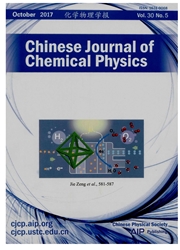

 中文摘要:
中文摘要:
使用1.54μm的激光脉冲(脉宽约10ns)诱导丹磺酰基标记的热敏性线性聚N-异丙基丙烯酰胺(PNIPAM)发生线团到小球的转变.当聚合物链中NIPAM单体与丹磺酰基基团的摩尔比由110增至300时,共价键合到聚合物主链上的丹磺酰基发色团对PNIPAM相转变行为的影响会随之减小.PNIPAM链塌缩经历成核过程(伴随着初始珍珠的形成,快弛豫时间Tfast=0.1ms)和珍珠的增长粗化阶段(慢弛豫时间Tslow=0.5ms),这与之前使用水溶性的-苯胺-8-萘磺酸铵盐作为荧光探针研究PNIPAM在水溶液中的折叠动力学得到的结果类似.Tfast在很宽的分子量范围内都与分子量无关,而Tslow则随链长增加而略有增大.
 英文摘要:
英文摘要:
The coil-to-globule transition of thermally sensitive linear poly(N-isopropylacrylamide) (PNIPAM) labeled with dansyl group is induced by 1.54 μm laser pulses (widths10 ns). The dansyl group is used to follow the transition kinetics because its fluorescence intensity is very sensitive to its micro-environment. As the molar ratio of NIPAM monomer to dansyl group increases from 110 to 300, the effect of covalently attached dansyl fluorophores on the transition decreases. In agreement with our previous study in which we used 8-anilino- l-naphthalensulfonic acid ammonium salt free in water as a fluorescent probe, the current study reveals that the transition has two distinct stages with two characteristic times, namely, Tfast≈0.1 ms, which can be attributed to the nucleation and formation of some "pearls" (locally contracting segments) on the chain, and tslow≈0.5 ms, which is related to the merging and coarsening of the "pearls".Tfast is independent of the PNIPAM chain length over a wide range (Mw=2.8× 10^6-4.2 × 10^7 g/mol). On the other hand, Tslow only slightly increases with the chain length.
 同期刊论文项目
同期刊论文项目
 同项目期刊论文
同项目期刊论文
 Molecular-level insights into N-N π-bond rotation in the pH-induced interfacial isomerization of 5-o
Molecular-level insights into N-N π-bond rotation in the pH-induced interfacial isomerization of 5-o Specific Ion Interaction Dominates over Hydrophobic Matching Effects in Peptide? Lipid Bilayer Inter
Specific Ion Interaction Dominates over Hydrophobic Matching Effects in Peptide? Lipid Bilayer Inter Fermi Resonant Interaction of the Tailed Methyl Groups of Langmuir Mono layer at the Air/Water Inter
Fermi Resonant Interaction of the Tailed Methyl Groups of Langmuir Mono layer at the Air/Water Inter Specific Anion Effect in Water-Nonaqueous Solvent Mixtures: Interplay of the Interactions between An
Specific Anion Effect in Water-Nonaqueous Solvent Mixtures: Interplay of the Interactions between An Electron transfer reactions between 1,8-dihydroxyanthraquinone and pyrimidines: A laser flash photol
Electron transfer reactions between 1,8-dihydroxyanthraquinone and pyrimidines: A laser flash photol Structure and Orientation of Interfacial Proteins Determined by Sum Frequency Generation Vibrational
Structure and Orientation of Interfacial Proteins Determined by Sum Frequency Generation Vibrational Cation-Specific Conformational Behavior of Polyelectrolyte Brushes: From Aqueous to Nonaqueous Solve
Cation-Specific Conformational Behavior of Polyelectrolyte Brushes: From Aqueous to Nonaqueous Solve Effect of dehydration on the interfacial water structure at a charged polymer surface: Negligible χ(
Effect of dehydration on the interfacial water structure at a charged polymer surface: Negligible χ( Integration of an Inorganic Semiconductor with a Metal–Organic Framework: A Platform for Enhanced Ga
Integration of an Inorganic Semiconductor with a Metal–Organic Framework: A Platform for Enhanced Ga Advanced experimental methods toward understanding biophysicochemical interactions of interfacial bi
Advanced experimental methods toward understanding biophysicochemical interactions of interfacial bi Interaction between Potassium Phosphate Buffer Solution and Modeling Cell Membrane Investigated by S
Interaction between Potassium Phosphate Buffer Solution and Modeling Cell Membrane Investigated by S Specific Ion Interaction Dominates over Hydrophobic Matching Effects in Peptide-Lipid Bilayer Intera
Specific Ion Interaction Dominates over Hydrophobic Matching Effects in Peptide-Lipid Bilayer Intera Phosphate Ions Promoting Association between Peptide and Modeling Cell Membrane Revealed by Sum Freq
Phosphate Ions Promoting Association between Peptide and Modeling Cell Membrane Revealed by Sum Freq Methanol Perturbing Modeling Cell Membranes Investigated using Linear and Nonlinear Vibrational Spec
Methanol Perturbing Modeling Cell Membranes Investigated using Linear and Nonlinear Vibrational Spec Molecular-Level Insights into N-N pi-Bond Rotation in the pH-Induced Interfacial Isomerization of 5-
Molecular-Level Insights into N-N pi-Bond Rotation in the pH-Induced Interfacial Isomerization of 5- Kinetics of Coil-to-Globule Transition of Dansyl-Labeled Poly(N-isopropylacrylamide) Chains in Aqueo
Kinetics of Coil-to-Globule Transition of Dansyl-Labeled Poly(N-isopropylacrylamide) Chains in Aqueo Visible-Light Photoexcited Electron Dynamics of Scandium Endohedral Metallofullerenes: The Cage Symm
Visible-Light Photoexcited Electron Dynamics of Scandium Endohedral Metallofullerenes: The Cage Symm Intermolecular Interactions at the Interface Quantified by Surface-Sensitive Second-Order Fermi Reso
Intermolecular Interactions at the Interface Quantified by Surface-Sensitive Second-Order Fermi Reso Effect of polystyrene-b-poly(ethylene oxide) on self-assembly of polystyrene-b-poly(N-isopropylacryl
Effect of polystyrene-b-poly(ethylene oxide) on self-assembly of polystyrene-b-poly(N-isopropylacryl Telechelic hydrid poly(acrylic acid)s containing polyhedral Oligomeric silsesquioxane (POSS) and the
Telechelic hydrid poly(acrylic acid)s containing polyhedral Oligomeric silsesquioxane (POSS) and the 期刊信息
期刊信息
